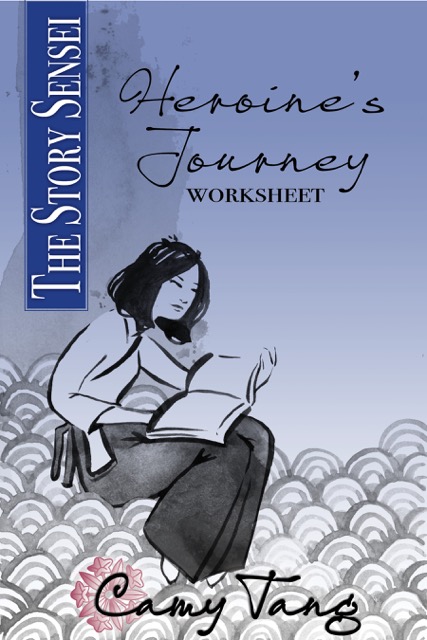Buy the Heroine's Journey worksheet
Story Sensei newsletter
If you'd like emails sent to you when each worksheet is available, feel free to subscribe to my Story Sensei newsletter. I won't clog up your email Inbox--For the first few months, I'll send one email a month because I'll be releasing my worksheets about once a month, but then after that I will only send out emails when I have a new Story Sensei product or a sale. I tend to have new worksheets only about once a year.
.pdf copies
If you bought my worksheet as a Kindle, iBooks, Nook, or Kobo ebook and you’d like a .pdf copy, forward your email receipt for the ebook to camy@camytang.com and I’ll send instructions for downloading a .pdf copy.
Already bought a worksheet?
If you bought a worksheet directly from me in the past, I'm happy to give you access to the page to download the updated version for free. Please message me and let me know the email address you used to buy it (if it’s different) so I can find your order.
Download worksheet
Looking for your worksheet(s) to download? The download page links are here. You need to login and you will only be able to see the page if you purchased the worksheet directly from me and I have had time to manually give you permission to view the page.

Sign up to receive updates!
Heroine's Journey worksheet
Make your character’s story arc resonate more emotionally with readers.
What is the Heroine’s Journey?
Joseph Campbell originally wrote about the Hero’s Journey in his book, The Hero With a Thousand Faces, as a psychological analysis of the classical myth formula. Maureen Murdock took Campbell’s work, her own psychology experience, and other psychoanalytical writings and world myths to develop The Heroine’s Journey for women.
Often, a male and female character will respond differently to conflict in a story because culture and time period will affect a character differently due to gender. As a result, their internal story arcs will differ according to gender, also.
Whether in romances or women’s fiction, often a heroine’s story arc is more about internal awakening as opposed to the “quest” style of the Hero’s Journey. This makes the Heroine’s Journey a good template for a heroine’s story arc.
If readers comment that there’s “something off” with a character’s story arc, the Heroine’s Journey applied to a heroine will often make her story more psychologically resonant and satisfying for a reader.
How this worksheet can help you:
This worksheet consists of the Heroine's Journey explained in detail, questions for you to answer about your heroine, and examples to explain each stage of the Heroine's Journey. It will guide you in an easy way toward applying the Heroine’s Journey structure for your heroine.
This worksheet will help you:
—Create a more emotionally resonant internal arc for your heroine
—Or change up your hero’s internal journey with one of self-discovery by applying the Heroine’s Journey to his story arc
—Fix and strengthen disjointed character development
—Manipulate and strengthen story pacing
—Keep a character’s internal arc in a forward-moving motion rather than stagnating
—Build the internal arc toward the “Black Moment” crisis
—Draw the internal arc full circle in a way that will satisfy readers
—Use the Heroine’s Journey even in a romance where there’s also a hero taking up 50% of the book
—Double-check that the external events in the story are fueling and forwarding the character’s internal arc
—Revise a synopsis or a completed manuscript
Please note: this tool is not meant to replace a synopsis because it doesn’t focus as strongly on the external events and conflicts in the story—it’s more focused on the internal events and internal conflicts of your heroine.
This worksheet was created by utilizing the compilation of information on the Heroine’s Journey derived not only from Maureen Murdock’s book, but also other psychology writings and an understanding of Joseph Campbell’s original Hero’s Journey. This newly revised edition includes extra examples for each stage of the Heroine’s Journey and more detail on previous examples.
Are you unsure why your heroine’s emotional story doesn’t strike the right chord with readers? This worksheet will help set you on the right track.
What is the Heroine’s Journey?
Joseph Campbell originally wrote about the Hero’s Journey in his book, The Hero With a Thousand Faces, as a psychological analysis of the classical myth formula. Maureen Murdock took Campbell’s work, her own psychology experience, and other psychoanalytical writings and world myths to develop The Heroine’s Journey for women.
Often, a male and female character will respond differently to conflict in a story because culture and time period will affect a character differently due to gender. As a result, their internal story arcs will differ according to gender, also.
Whether in romances or women’s fiction, often a heroine’s story arc is more about internal awakening as opposed to the “quest” style of the Hero’s Journey. This makes the Heroine’s Journey a good template for a heroine’s story arc.
If readers comment that there’s “something off” with a character’s story arc, the Heroine’s Journey applied to a heroine will often make her story more psychologically resonant and satisfying for a reader.
How this worksheet can help you:
This worksheet consists of the Heroine's Journey explained in detail, questions for you to answer about your heroine, and examples to explain each stage of the Heroine's Journey. It will guide you in an easy way toward applying the Heroine’s Journey structure for your heroine.
This worksheet will help you:
—Create a more emotionally resonant internal arc for your heroine
—Or change up your hero’s internal journey with one of self-discovery by applying the Heroine’s Journey to his story arc
—Fix and strengthen disjointed character development
—Manipulate and strengthen story pacing
—Keep a character’s internal arc in a forward-moving motion rather than stagnating
—Build the internal arc toward the “Black Moment” crisis
—Draw the internal arc full circle in a way that will satisfy readers
—Use the Heroine’s Journey even in a romance where there’s also a hero taking up 50% of the book
—Double-check that the external events in the story are fueling and forwarding the character’s internal arc
—Revise a synopsis or a completed manuscript
Please note: this tool is not meant to replace a synopsis because it doesn’t focus as strongly on the external events and conflicts in the story—it’s more focused on the internal events and internal conflicts of your heroine.
This worksheet was created by utilizing the compilation of information on the Heroine’s Journey derived not only from Maureen Murdock’s book, but also other psychology writings and an understanding of Joseph Campbell’s original Hero’s Journey. This newly revised edition includes extra examples for each stage of the Heroine’s Journey and more detail on previous examples.
Are you unsure why your heroine’s emotional story doesn’t strike the right chord with readers? This worksheet will help set you on the right track.
Buy the Heroine's Journey worksheet
© 2025 Camy Tang


